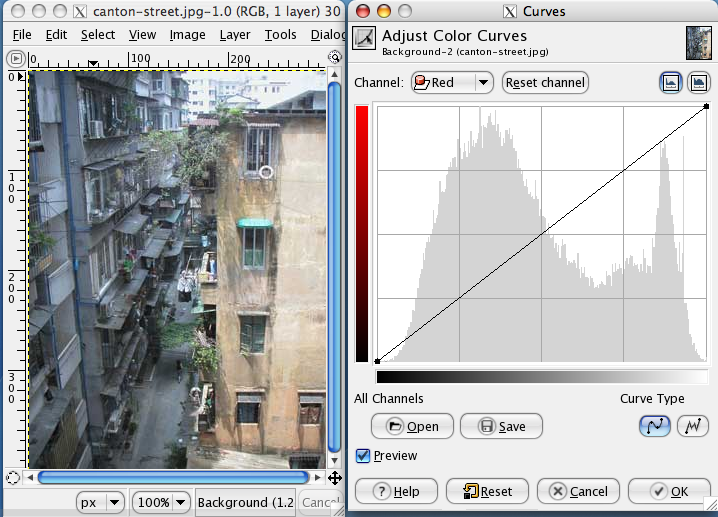|
Agfacontour Professional
Agfacontour Professional was (as of 2002 not anymore produced) a special emulsion sheet film which, after exposure and development in the Agfacontour developer, produced direct equidensities. Agfacontour was introduced in 1970 by Agfa-Gevaert to produce equidensities by a direct, one-developing-step process. Until then equidensities had to be obtained using one of the following techniques: *The most popular method to obtain equidensities was the ''One-Film'' technique, better known as Sabattier effect (a.k.a. Pseudosolarization). *Another technique, making tonal extractions on high-contrast film, was called the ''Two-Film'' technique (negative-positive process): from a negative 3-5 different exposures were made on ultra high-contrast lith-films. These 3-5 positives were then copied again on ultra high-contrast lith-film to obtain negatives with virtually no grey tones. Then one positive and a negative from a different set were sandwiched together in register to obtain one spec ... [...More Info...] [...Related Items...] OR: [Wikipedia] [Google] [Baidu] |
Equidensitometry
Equidensitometry is the technique of measuring ''equidensities'' in a photographic deposit or photographic layer, such as photographic films and photographic plates. *Equidensities are points, lines and areas having equal densities also called isodensities. * First order equidensities are points, lines and areas having isodensities obtained by applying one of the listed below techniques once, thus they exhibit one particular Density in the original *Second order equidentities are points and lines having isodensities obtained by applying one of the listed below techniques twice, thus they exhibit two particular Densities in the original. Second order equidensities do not normally show areas. * Equidensity series is a sandwich (in register) of a number of different equidensities. Usually each equidensity is coded by color or raster. Photographic and computerized image processing techniques Four techniques of obtaining equidensities are: * Tone separation process * Sabattier effect ... [...More Info...] [...Related Items...] OR: [Wikipedia] [Google] [Baidu] |
Agfa-Gevaert
Agfa-Gevaert N.V. (Agfa) is a Belgian-German multinational corporation that develops, manufactures, and distributes analogue and digital imaging products, software, and systems. It has three divisions: * Agfa Graphics, which offers integrated prepress and industrial inkjet systems to the printing and graphics industries. * Agfa HealthCare, which supplies hospitals and other care organisations with imaging products and systems, and information systems. * Agfa Specialty Products, which supplies products to various industrial markets. It is part of the Agfa Materials organization. In addition to the Agfa Specialty Products activities, Agfa Materials supplies film and related products to Agfa Graphics and Agfa HealthCare. Agfa film and film cameras were once prominent consumer products. However, in 2004, the consumer imaging division was sold to a company founded via management buyout. AgfaPhoto GmbH, as the new company was called, filed for bankruptcy after just one year, [...More Info...] [...Related Items...] OR: [Wikipedia] [Google] [Baidu] |
Sabattier Effect
The Sabatier effect, also known as pseudo-solarization (or pseudo-solarisation) and erroneously referred to as the Sabattier effect, is a phenomenon in photography in which the image recorded on a Negative (photography), negative or on a photographic print is wholly or partially reversed in tone. Dark areas appear light or light areas appear dark. Solarization and pseudo-solarization are quite distinct effects. Over time, the "pseudo" has been dropped in many photographic darkroom circles and discussions, but the effect that is meant is the Sabattier effect and not the solarization by extreme overexposure (see below). Background Initially, the term "solarization (photography), solarization" was used to describe the effect observed in cases of extreme overexposure of the photographic film or plate in the camera. The effect generated in the dark room was then called ''pseudo-solarization''. Spencer defines the Sabattier effect as: "Partial image reversal produced by brief exposur ... [...More Info...] [...Related Items...] OR: [Wikipedia] [Google] [Baidu] |
Lith Print
A lith print is an alternative photographic printing process that uses infectious development to achieve its distinct look. Lith print usually has harsh and gritty shadows. In lith print development, formaldehyde is added to the developer, in order to lock excess sulphite that is used to regulate development in "normal" B&W print. Process Lith print typically uses sometimes outdated Bromide papers such as Fomatone MG Classic, Fomabrom Variant III, Slavich Unibrom, and Moersch Easy Lith, see list of papers known to lith well (http://www.alternativephotography.com/lithprint-materials-update/) among many even rarer Bromide papers that have long since gone out of production black-and-white these often bromide formulated papers are in most instances developed with dilute lithographic developing chemistry (Moersch Easy Lith A&B, Kodalith sold in A and B powdered packages, and a few others also out of production developer (often heavily diluted 1:20 and 1:15 Working strength developer, ... [...More Info...] [...Related Items...] OR: [Wikipedia] [Google] [Baidu] |
Black And White
Black-and-white (B&W or B/W) images combine black and white in a continuous spectrum, producing a range of shades of grey. Media The history of various visual media began with black and white, and as technology improved, altered to color. However, there are exceptions to this rule, including black-and-white fine art photography, as well as many film motion pictures and art film(s). Photography Contemporary use Since the late 1960s, few mainstream films have been shot in black-and-white. The reasons are frequently commercial, as it is difficult to sell a film for television broadcasting if the film is not in color. 1961 was the last year in which the majority of Hollywood films were released in black and white. Computing In computing terminology, ''black-and-white'' is sometimes used to refer to a binary image consisting solely of pure black pixels and pure white ones; what would normally be called a black-and-white image, that is, an image containing shades of ... [...More Info...] [...Related Items...] OR: [Wikipedia] [Google] [Baidu] |
Halftone
Halftone is the reprographic Reprography (a portmanteau of ''reproduction'' and ''photography'') is the reproduction of graphics through mechanical or electrical means, such as photography or xerography. Reprography is commonly used in catalogs and archives, as well as in th ... technique that simulates continuous-tone imagery through the use of dots, varying either in size or in spacing, thus generating a gradient-like effect.Campbell, Alastair. The Designer's Lexicon. ©2000 Chronicle, San Francisco. "Halftone" can also be used to refer specifically to the image that is produced by this process. Where continuous-tone imagery contains an infinite range of colors or greys, the halftone process reduces visual reproductions to an image that is printed with only one color of ink, in dots of differing size (pulse-width modulation) or spacing (frequency modulation) or both. This reproduction relies on a basic optical illusion: when the halftone dots are small, the human eye inter ... [...More Info...] [...Related Items...] OR: [Wikipedia] [Google] [Baidu] |
Gamma Correction
Gamma correction or gamma is a nonlinear operation used to encode and decode luminance or tristimulus values in video or still image systems. Gamma correction is, in the simplest cases, defined by the following power-law expression: : V_\text = A V_\text^\gamma, where the non-negative real input value V_\text is raised to the power \gamma and multiplied by the constant ''A'' to get the output value V_\text. In the common case of , inputs and outputs are typically in the range 0–1. A gamma value \gamma 1 is called a ''decoding gamma'', and the application of the expansive power-law nonlinearity is called gamma expansion. Explanation Gamma encoding of images is used to optimize the usage of bits when encoding an image, or bandwidth used to transport an image, by taking advantage of the non-linear manner in which humans perceive light and color. The human perception of brightness ( lightness), under common illumination conditions (neither pitch black nor blindingly bright), fol ... [...More Info...] [...Related Items...] OR: [Wikipedia] [Google] [Baidu] |
Graphics Software
In computer graphics, graphics software refers to a program or collection of programs that enable a person to manipulate images or models visually on a computer. Computer graphics can be classified into two distinct categories: raster graphics and vector graphics, with further 2D and 3D variants. Many graphics programs focus exclusively on either vector or raster graphics, but there are a few that operate on both. It is simple to convert from vector graphics to raster graphics, but going the other way is harder. Some software attempts to do this. In addition to static graphics, there are animation and video editing software. Different types of software are often designed to edit different types of graphics such as video, photos, and vector-based drawings. The exact sources of graphics may vary for different tasks, but most can read and write files. Most graphics programs have the ability to import and export one or more graphics file formats, including those formats written for ... [...More Info...] [...Related Items...] OR: [Wikipedia] [Google] [Baidu] |
Curve (tonality)
In image editing, a curve is a remapping of image tonality, specified as a function from input level to output level, used as a way to emphasize colours or other elements in a picture. Curves can usually be applied to all channels together in an image, or to each channel individually. Applying a curve to all channels typically changes the brightness in part of the spectrum. Light parts of a picture can be easily made lighter and dark parts darker to increase contrast. Applying a curve to individual channels can be used to stress a colour. This is particularly efficient in the Lab colour space due to the separation of luminance and chromaticity, but it can also be used in RGB, CMYK or whatever other colour models the software supports. See also * Blend modes * Image histogram * Hurter–Driffield curve Sensitometry is the scientific study of light-sensitive materials, especially photographic film. The study has its origins in the work by Ferdinand Hurter and Vero Charles Dr ... [...More Info...] [...Related Items...] OR: [Wikipedia] [Google] [Baidu] |
Cow Agfacontour, Chromogenic Development Of Equidenities Serie
Cattle (''Bos taurus'') are large, domesticated, cloven-hooved, herbivores. They are a prominent modern member of the subfamily Bovinae and the most widespread species of the genus ''Bos''. Adult females are referred to as cows and adult males are referred to as bulls. Cattle are commonly raised as livestock for meat (beef or veal, see beef cattle), for milk (see dairy cattle), and for hides, which are used to make leather. They are used as riding animals and draft animals ( oxen or bullocks, which pull carts, plows and other implements). Another product of cattle is their dung, which can be used to create manure or fuel. In some regions, such as parts of India, cattle have significant religious significance. Cattle, mostly small breeds such as the Miniature Zebu, are also kept as pets. Different types of cattle are common to different geographic areas. Taurine cattle are found primarily in Europe and temperate areas of Asia, the Americas, and Australia. Zebus (also call ... [...More Info...] [...Related Items...] OR: [Wikipedia] [Google] [Baidu] |
Photographic Films
Photography is the visual art, art, application, and practice of creating durable images by recording light, either electronically by means of an image sensor, or chemically by means of a light-sensitive material such as photographic film. It is employed in many fields of science, manufacturing (e.g., photolithography), and business, as well as its more direct uses for art, film and video production, recreational purposes, hobby, and Mass communication, mass communication. Typically, a Lens (optics), lens is used to focus (optics), focus the light reflected or emitted from objects into a real image on the light-sensitive surface inside a camera during a timed Exposure (photography), exposure. With an electronic image sensor, this produces an Charge-coupled device, electrical charge at each pixel, which is Image processing, electronically processed and stored in a Image file formats, digital image file for subsequent display or processing. The result with photographic emulsion is ... [...More Info...] [...Related Items...] OR: [Wikipedia] [Google] [Baidu] |







